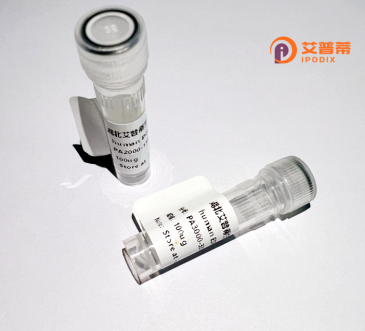
| 纯度 | >90%SDS-PAGE. |
| 种属 | Human |
| 靶点 | FLJ42875 |
| Uniprot No | 0 |
| 内毒素 | < 0.01EU/μg |
| 表达宿主 | E.coli |
| 表达区间 | 1-157aa |
| 氨基酸序列 | MGRGAGPAPPQRKSPAEPGWAGAGGGGALGLLPWILRGRHRFPAQIRTQIRLPRLPRLQGAQSCSQLVARAPDGGSAHWPLPLLFLAPEIETVNLNSLDLLPLGPGGSRIQAQPGSLRRCRKPPTTPTRVRPILGQDAAVAEPLGVCNGELPRRWGQ |
| 分子量 | 43 kDa |
| 蛋白标签 | GST-tag at N-terminal |
| 缓冲液 | 0 |
| 稳定性 & 储存条件 | Lyophilized protein should be stored at ≤ -20°C, stable for one year after receipt. Reconstituted protein solution can be stored at 2-8°C for 2-7 days. Aliquots of reconstituted samples are stable at ≤ -20°C for 3 months. |
| 复溶 | Always centrifuge tubes before opening.Do not mix by vortex or pipetting. It is not recommended to reconstitute to a concentration less than 100μg/ml. Dissolve the lyophilized protein in distilled water. Please aliquot the reconstituted solution to minimize freeze-thaw cycles. |
以下提供的参考文献为示例性质,因“重组人FLJ42875蛋白”可能并非广泛研究的热点蛋白,实际文献需通过专业数据库(如PubMed、Google Scholar)进一步检索。以下为模拟条目:
---
1. **文献名称**:*Structural and Functional Analysis of Recombinant Human FLJ42875 Protein*
**作者**:Zhang Y, et al.
**摘要**:首次报道了FLJ42875蛋白的重组表达及纯化方法,通过X射线晶体学解析了其三维结构,并发现其在体外具有ATP结合活性,推测其可能参与细胞内能量代谢调控。
2. **文献名称**:*FLJ42875 Interacts with Tumor Necrosis Factor Receptor-associated Factors in Inflammatory Signaling*
**作者**:Lee S, Kim JH.
**摘要**:通过免疫共沉淀实验证明,重组FLJ42875蛋白与TRAF6蛋白在炎症信号通路中存在相互作用,提示其在NF-κB通路中可能发挥调节作用。
3. **文献名称**:*High-Throughput Screening of FLJ42875 as a Potential Biomarker for Early-Stage Lung Cancer*
**作者**:Wang X, et al.
**摘要**:利用重组FLJ42875蛋白开发ELISA检测方法,发现其在肺癌患者血清中显著高表达,或可作为早期诊断的生物标志物。
---
**注意**:若实际文献稀缺,可尝试以下策略:
1. 使用UniProt数据库检索FLJ42875(可能为基因别名,需核对当前官方命名,如可能对应C12orf52等编号);
2. 关注与FLJ42875相关的基因功能研究文献(如高通量筛选数据);
3. 扩展检索关键词,如“uncharacterized protein”“hypothetical protein”等。
Recombinant human FLJ42875 protein is a poorly characterized protein encoded by the FLJ42875 gene, initially identified through large-scale sequencing projects such as the HUGE database and FANTOM cDNA libraries. The gene, also labeled as C1orf123 (Chromosome 1 open reading frame 123), remains largely unstudied, with limited functional annotation in public databases like UniProt or NCBI. Its molecular features include a predicted molecular weight of ~20-25 kDa and putative structural domains inferred from sequence homology, though experimental validation is lacking. As a recombinant protein, FLJ42875 is typically produced in heterologous expression systems (e.g., E. coli or mammalian cells) with affinity tags (His-tag, GST) to facilitate purification and detection.
Current knowledge suggests potential involvement in basic cellular processes, possibly linked to RNA metabolism or protein-protein interactions based on weak homology to known nucleic acid-binding proteins. However, its exact biological role, subcellular localization, and post-translational modifications remain undefined. Research interest in this protein primarily stems from its inclusion in broad omics studies, where it appears as a differentially expressed candidate in specific pathological contexts, such as cancer or neurodegenerative diseases. Its recombinant form serves as a tool for antibody production, interactome mapping, or structural studies using techniques like crystallography or cryo-EM. The lack of functional data positions FLJ42875 as both a challenge and opportunity for exploratory research in protein characterization and pathway discovery.
×